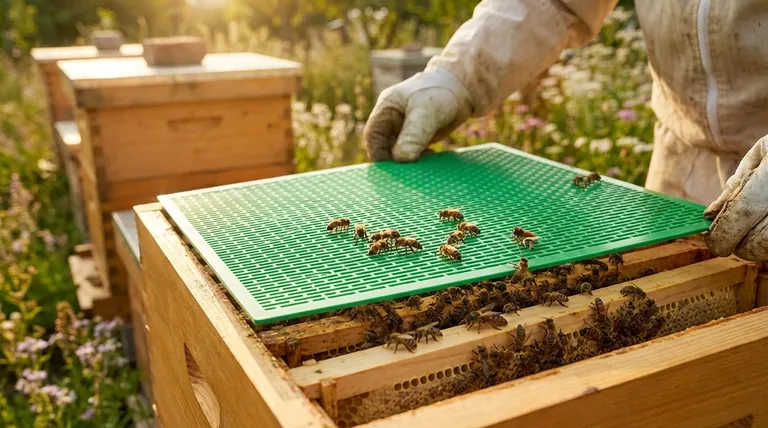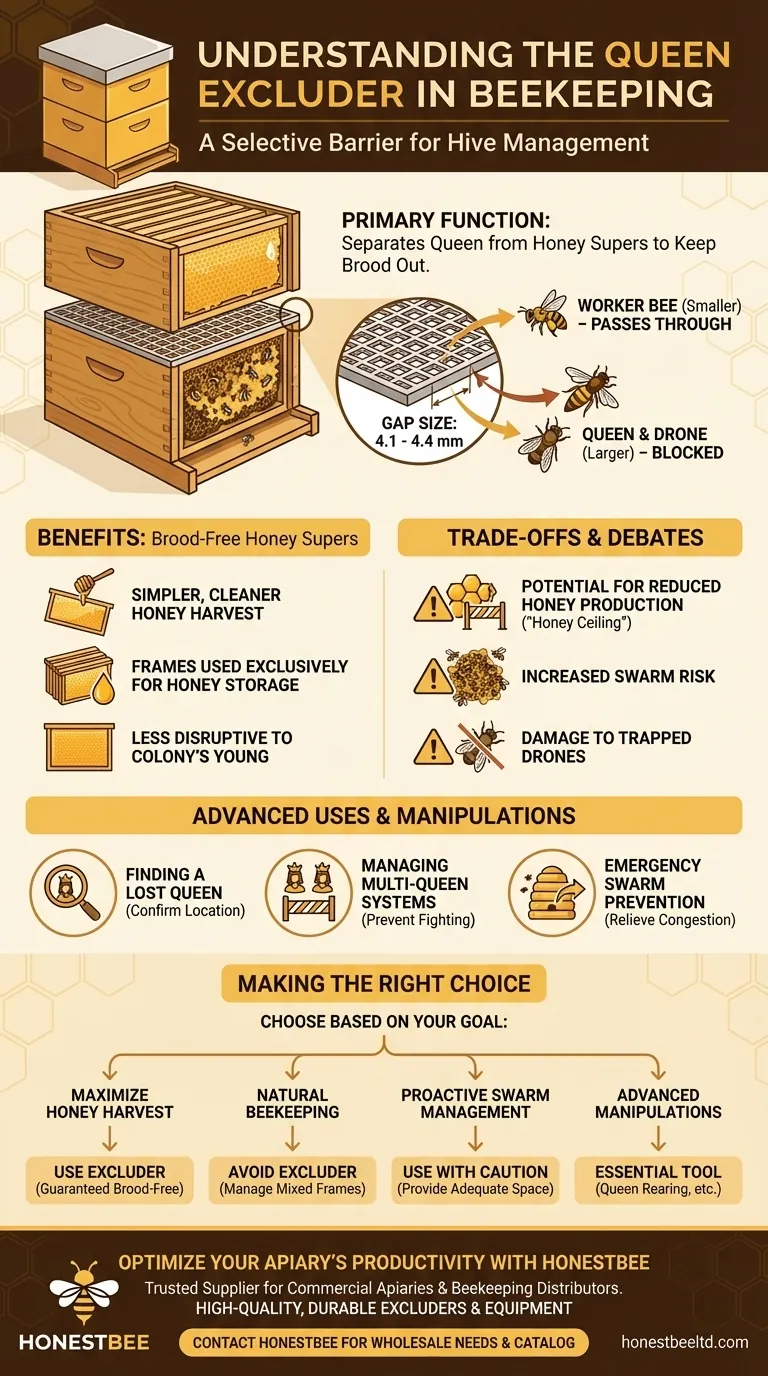A queen excluder is a selective barrier placed inside a beehive to control where the queen can lay her eggs. It is a grid, typically made of metal or plastic, with openings that are large enough for worker bees to pass through but too small for the physically larger queen and drones. This simple device ensures honey storage areas remain separate from the brood-rearing areas of the hive.
The decision to use a queen excluder is a foundational choice in beekeeping strategy. It pits the goal of pristine, easy-to-harvest honey against potential impacts on hive productivity and the natural flow of the colony. Understanding this trade-off is key to effective hive management.

The Fundamental Principle: Size-Based Segregation
A queen excluder is a simple but highly effective tool that works by exploiting the physical differences between the members of a bee colony.
Anatomy of an Excluder
An excluder is a flat screen or grid. The critical design feature is the size of the gaps, which are precisely engineered to be between 4.1 and 4.4 millimeters.
These grids are most commonly made from slotted metal wire or molded plastic. They are designed to match the dimensions of the hive boxes they are placed between.
Exploiting Bee Biology
The entire function of the excluder relies on a simple fact: worker bees are smaller than queens and drones.
The worker bees' thoraxes are small enough to slip through the 4.1 mm gaps with ease. The queen, however, has a significantly larger thorax and is physically blocked from passing through the grid. Male bees, or drones, are also too large to pass through.
The Primary Application: Brood-Free Honey Supers
For most beekeepers, the main reason to use a queen excluder is to simplify the honey harvest by creating a "honey-only" zone in the hive.
The Problem: A Queen's Instinct
A healthy queen's primary job is to lay eggs—up to 2,000 per day. She will seek out empty cells anywhere in the hive to do this. Without intervention, she will gladly move into the upper boxes (honey supers) and lay eggs, creating a mix of honey, pollen, and developing bees (brood) on the same frames.
The Solution: Confining the Queen
By placing a queen excluder between the lower hive boxes (the brood chamber) and the upper honey supers, the beekeeper creates a hard boundary. The queen is confined to the brood chamber, where she continues to lay eggs and maintain the colony's population.
The Benefit for the Beekeeper
This separation ensures that the frames in the honey supers are used exclusively for storing nectar and ripening it into honey. When it comes time to harvest, the beekeeper can remove frames that are full of pure, capped honey, without having to work around patches of brood. This makes extraction cleaner, faster, and less disruptive to the colony's young.
Understanding the Trade-offs and Debates
While effective, the use of a queen excluder is a topic of debate among beekeepers. Its benefits come with potential downsides.
Potential for Reduced Honey Production
Some beekeepers believe the excluder creates a "honey ceiling"—a barrier that worker bees are reluctant to cross. This can lead to the bees storing more honey in the brood chamber and less in the supers above. Over time, the constant passage through the grid can also cause minor abrasion to the workers' wings.
Increased Swarm Risk
By strictly limiting the queen's laying space, the brood nest can become congested with bees, honey, and pollen more quickly. This congestion is a primary trigger for the colony to swarm, which is the natural method of colony reproduction where the old queen leaves with about half the bees.
Damage to Drones
Drones that happen to emerge from cells in the honey supers (from before the excluder was placed) will be trapped above the excluder and unable to get back to the brood nest, causing them to die.
Advanced Uses Beyond Honey Production
For experienced beekeepers, the queen excluder is a versatile tool for more complex hive manipulations.
Finding a Lost Queen
If a beekeeper needs to locate the queen in a hive with multiple brood boxes, they can place an excluder between the boxes. After three to four days, an inspection will reveal which box contains new eggs, confirming the queen's location.
Managing Multi-Queen Systems
In advanced setups involving two queens in a single colony, excluders are essential. They are used to keep the queens separated, preventing them from fighting and killing one another while allowing worker bees to move freely throughout the entire hive.
Emergency Swarm Prevention
As part of specific swarm management techniques, an excluder can be used to separate the queen from the majority of the young brood, temporarily relieving the congestion that triggers swarming.
Making the Right Choice for Your Goal
Deciding whether to use a queen excluder depends entirely on your management style and objectives.
- If your primary focus is maximizing honey harvest with the simplest extraction: Use a queen excluder to guarantee brood-free honey supers.
- If your primary focus is "natural beekeeping" with minimal intervention: Avoid the excluder and be prepared to manage frames with mixed honey and brood.
- If your primary focus is proactive swarm management: Use an excluder with caution, ensuring you provide adequate space in the brood nest to prevent congestion.
- If you are an advanced beekeeper practicing complex manipulations: The excluder is an essential tool for techniques like queen rearing or managing two-queen colonies.
Ultimately, the queen excluder is a tool of control, and deciding whether to use it depends on your specific beekeeping philosophy and goals.
Summary Table:
| Feature | Details |
|---|---|
| Primary Function | Separates the queen from honey supers to keep brood out of honeycomb. |
| Gap Size | 4.1 - 4.4 mm; allows worker bees to pass but blocks the queen and drones. |
| Common Materials | Metal wire or molded plastic. |
| Main Benefit | Ensures frames in honey supers contain only honey for a cleaner, easier harvest. |
| Key Consideration | Potential for reduced honey yield and increased swarm risk if not managed correctly. |
Optimize Your Apiary's Productivity with HONESTBEE
Mastering hive management tools like the queen excluder is key to a successful harvest. As a trusted supplier for commercial apiaries and beekeeping equipment distributors, HONESTBEE provides the high-quality, durable supplies you need to implement these strategies effectively.
We offer a comprehensive wholesale catalog featuring everything from essential tools like queen excluders to full hive systems, designed to meet the demands of large-scale operations. Partner with us to ensure your beekeeping business is equipped for efficiency and growth.
Contact HONESTBEE today to discuss your wholesale needs and discover how our equipment can support your apiary's success.
Visual Guide

Related Products
- High Performance Plastic Queen Excluder for Beekeeping and Apiary Management
- Professional Plastic Queen Excluder for Modern Beekeeping
- Wooden Queen Bee Excluder for Beekeeping
- HONESTBEE 6 Frame Three Use Electric Honey Extractor for Beekeeping
- Metal Queen Bee Excluder for Beekeeping
People Also Ask
- When should I remove my queen excluder? Timing is Critical for Winter Bee Survival
- What impact does a queen excluder have on colony defensiveness? Control Hive Temperament for Safer Beekeeping
- When is the typical time frame for harvesting honey and removing the queen excluder? Optimize Your Hive Management
- What happens if I don't use a queen excluder? Understand the impact on your honey harvest.
- What materials are modern queen excluders made from? Choose the Right Material for Your Apiary



















